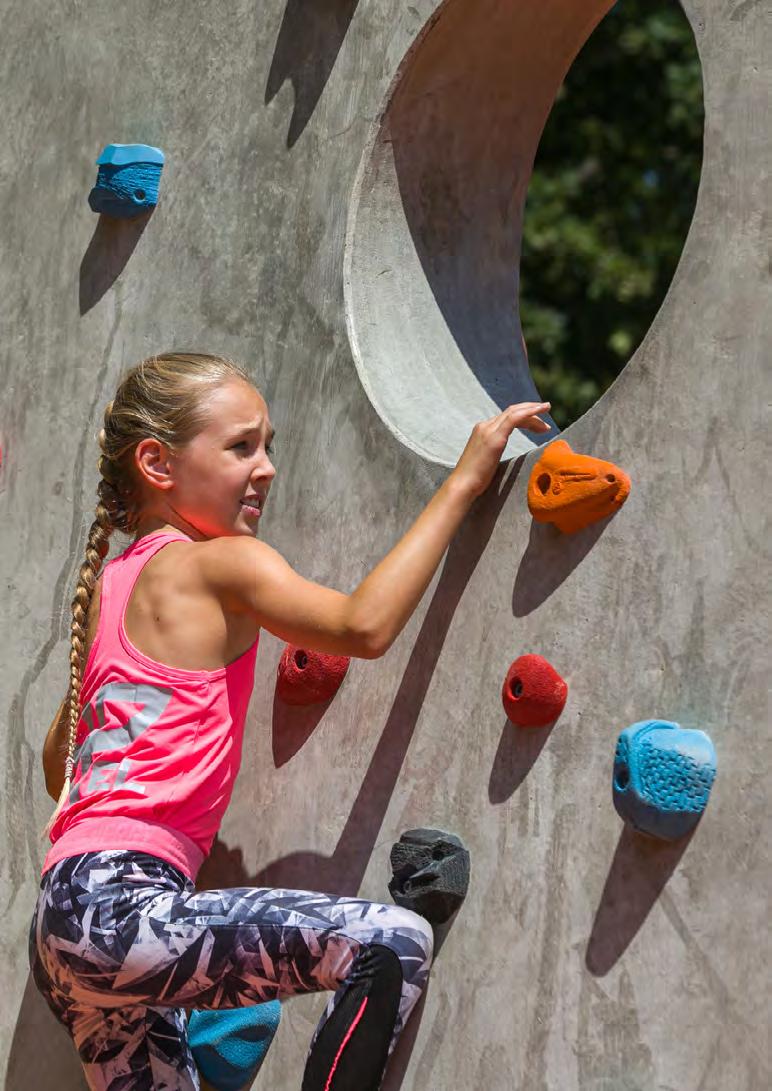PRESENTATION
The Sales Guide of the Liget Budapest Project’s Developments



Europe’s new, exciting and most complex cultural quarter is being built in Budapest, which every Hungarian can be proud of. The Liget Budapest Project, launched in 2011, is now the continent’s largest-scale, amply accoladed urban cultural development programme. Its objective is the complex development of the 100-hectare Városliget (City Park) in Budapest: the renewal and extension of the park’s green areas and recreation functions as well as its centuries old institutions.
The City Park is a unique urban park looking back on a tradition of some 150 years. With its museums, exhibition venues, ZOO, thermal bath, ice-rink, circus, sports grounds and playgrounds it offers numerous ways of recreation for visitors. Thanks to the Liget Project, this part of the city is being revamped to meet 21st-century requirements, while also preserving traditions. Examples include the reconstruction of the reconstruction and modernisation of the imposing building of the nearly 120-year-old Museum of Fine Arts, and the construction of new buildings, such as the House of Music Hungary, designed by Japanese star architect Sou Fujimoto, which opened in early 2022 and has already pocketed numerous international awards, as well as the new, iconic building of the Museum of Ethnography, opened last summer, and the New National Gallery, designed by Pritzker Prize-laureate SANAA and planned to be built in the near future.
In the meantime, the park’s green areas have been significantly increased and renewed to offer a higher quality. We are only halfway through the implementation process of this project, unique in Hungary’s history, but the results of the historic undertaking are already visible: in the past three years, almost seven million visitors have used the new developments: the renovated and modernised institutions and the new buildings, as well as the revamped parts of the park.
Thanks to the Liget Budapest Project, the City Park – a cultural quarter with a more than 150-year past but renewed and expanded to a 21st-century standard – will become a unique attraction of the Hungarian capital on the cultural map of Europe.
Budapest is one of Europe’s most beautiful and dynamically growing tourist destinations. This position is confirmed by the guest turnover data, which steadily increased until 2019, and numerous recognitions, such as:
• Europe’s Leading Tourism Development Project, World Travel Awards, 2023
• B est Tourism Development Project, International Travel Awards, 2023
• 2nd best value for money destination, Lonely Planet, 2020
• Top 10 Cultural Tourists Destinations, 2020
• Top 10 Most Popular Destinations, 2020
• Award for Best European Destination, 2019/2020
• 4th most rapidly growing European destination, Europamonitor research, 2017
The Liget Budapest Project plays a special role in international tourism, restarting after COVID19, as it is here that the Museum of Ethnography and the House of Music Hungary found a home, and the Museum of Fine Arts and the House of the Hungarian Millennium were restored to their original glory.
• Liget Budapest Project
◦ MIPIM – Europe’s Best Urban Development Megaproject 2017
◦ World Travel Awards – Europe’s Leading Tourism Development Project 2023
◦ International Tourism Awards – Best Tourism Development Project Europe 2023
• House of Music Hungary
◦ International Property Awards - Best International Public Service Architecture, 2019
◦ Music Cities Awards - World’s Best Use of Music in Property Development, 2020
◦ CNN – World’s Most Anticipated Buildings, 2021
◦ Portfolio Property Awards – Special Award, 2022
◦ Time Out Magazine – World’s Best Cultural Attractions in 2022
◦ MIPIM Awards, Cannes – Jury’s Main Prize, 2022
◦ German Design Council - Iconic Award, 2022
◦ World Travel Awards – Europe’s Leading New Tourist Attraction, 2022
◦ Architecture Masterprize - Architectural Design of the Year, 2022
◦ Time Magazine - World’s Greatest Places, 2023
• Museum of Ethnography
◦ International Property Awards – World’s Best Public Service Architecture, 2018
◦ International Property Awards - World’s Best Architecture Main Prize, 2018
◦ II. National Salon of Architecture, Audience Award, 2019
◦ Time Magazine - World’s Greatest Places, 2023
◦ ARCHITIZER A+AWARDS Museum category, 2023
◦ IAA AWARD CHICAGO, 2023
• Museum of Fine Arts
◦ Europa Nostra Award – European Heritage Awards, 2020
• National Museum conservation and Storage Centre
◦ International Property Awards – Best Public Service Architecture Europe, 2021
◦ Budapest Award for Architectural Excellence – Certificate of Merit, 2020
• House of the Hungarian Millennium
◦ FIABCI XXII. Hungarian Prix d’Excellence (Hungarian Real Estate Development Award) – Culture category, 2020
◦ Budapest Construction Industry Excellence Award –Monument Reconstruction, 2020
◦ Bernhard Remmers Academy – Historic Monument Preservation, winner of the International category, 2022
• Star Fortress Komárom
◦ Budapest Construction Industry Excellence Award –Monument Reconstruction, 2020
• Museum Underground Parking
◦ Construction Industry Excellence Award – Transport Facility category, 2021
• Main Playground
◦ Landscape Architecture Excellence Award – Playgrounds, Sportsgrounds category, 2021
The Liget Budapest devotes special attention to liaising and cooperation with its professional and business partners. The Liget Budapest Sales Guide contains all the information and solutions that can help the work of its professional and business partners:
• It provides general information about the whole park.
• It provides detailed information in a unified structure for each facility about its cultural, leisure, educational and gastronomic features, as well as available event capacity.
• It provides answers to questions that can facilitate the sales and business development work of its business partners.
The buildings of the Liget Budapest Project are all certified as excellent as confirmed by the certificates awarded to them by the international BREEAM (Building Research Establishment Environmental Assessment Methodology) certificates. What it means is that the building construction guarantees that it will automatically use the amount of energy that is necessary to cater to the needs of the visitors inside.
The facilities and services of the Liget Budapest Project are all accessible and its use is made suitable for the physically impaired.
900 rooms are available for individuals or groups of visitors in the immediate environment of the Liget Budapest.


The City Park, where the Liget Budapest is located, can be easily reached from Budapest’s city centre along Andrássy Road, either by public transport, on foot or by bicycle along Andrássy Road. The City Park is accessible via numerous public transportation routes:
• Tram 1 connects the City Park with the Buda districts in two directions (Óbuda and Lágymányos)
• Bus 105 provides a direct link with the city centre
• Trolleybus 78, buses 20/20E: link with Keleti railway station
• Trolleybus 72: link with Nyugati railway station
• Trolleybus 75: link with Stadionok/Papp László Sportaréna stop
• Trolleybus 74 and M1: link with Deák Ferenc Square
The City Park can be reached from the Ferenc Liszt Airport by bus 100 and then the M1; and in about 40 minutes by car.
People coming here by car can park in the Museum Underground car park, with a capacity for 800 vehicles, at the corner of Dózsa György Road and Ajtósi Dürer Road.
For groups coming by bus we have designated pick-up and drop-off points, where vehicles can stop for a brief period: on OLOF Palme Promenade by the side of the Műcsarnok (Kunsthalle), and on the section of Állatkerti Boulevard by Heroes’ Square. Tour buses can stop at these locations to drop off and collect passengers. Longterm parking is possible in the places marked on the map below: on Hermina Road, and in Verseny Street (parking fee applies on weekdays).

Stopping is not permitted on Heroes’ Square.
Alighting and boarding vehicles in front of the Műcsarnok is not permitted.
Pick-up/drop-off points by the side of the Műcsarnok on Olof Palme Promenade can be used, strictly for the duration of boarding/alighting.
In all cases, the parking regulations and tariffs valid in the given area apply.
Pick-up/drop-off points at the beginning of Állatkerti Boulevard, by the Robinson Restaurant can be used, strictly for the duration of boarding/ alighting.
Short-term parking - 15-20 minutes – is possible on Hermina Road, where six new parking spaces are designated on Bethesda Street.
If you need long-term parking, please use the parking spaces on Dózsa György Road, opposite the BOK (formerly SYMA) Hall.
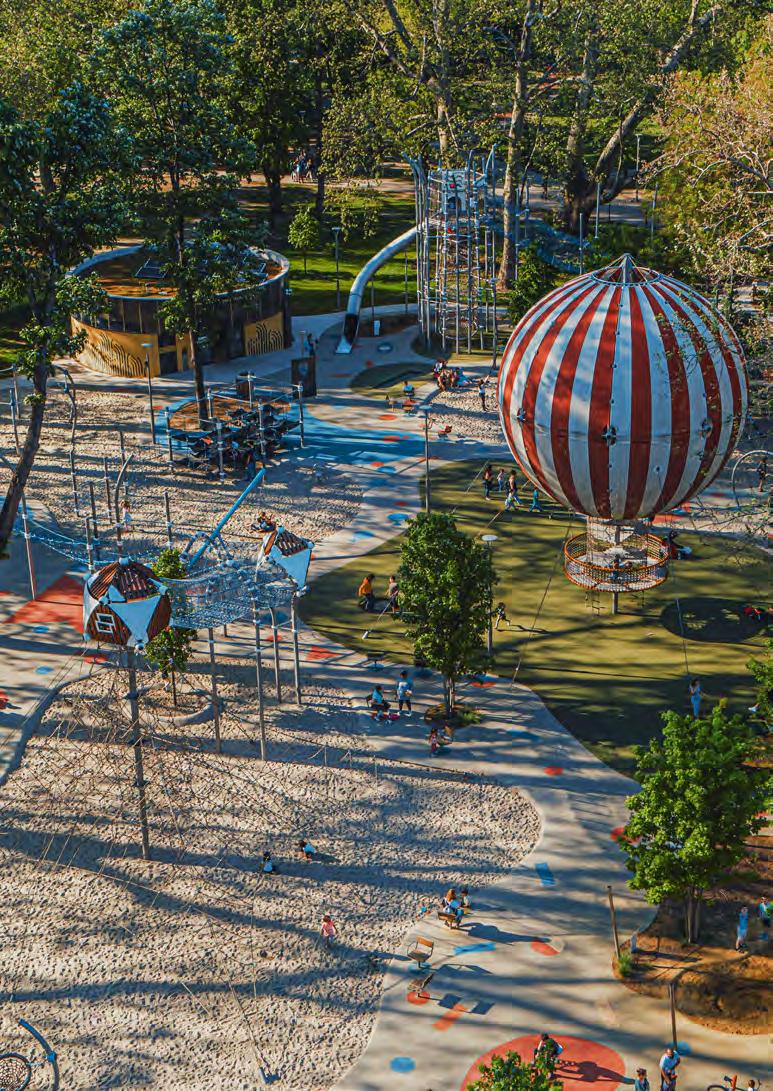
Thanks to the Liget Budapest’s first renovation project, the House of the Hungarian Millennium was given special features:
• THE MAGIC OF THE GOLDEN AGE - After the complete historical restoration of the building in 1885, visitors can take a journey into the golden age of Budapest.
• COLOURFUL ROSE GARDEN - The first rose garden in the history of the City Park further enhances the romantic atmosphere of the building.
• WORLD-FAMOUS ZSOLNAY CERAMICS - The decorative tiles blend in harmoniously with the restored original pieces on the facade, in the restaurant, in a special collection, as well as on the fountain in the Rose Garden.
• NEO Contemporary Art Space – This exhibition venue with a floor space of 350 square metres provides an opportunity for the display of a wide spectrum of contemporary works and installations.
• RESTAURANT, CAFÉ AND TERRACE – In a unique atmosphere evoking the era of Art Nouveau, visitors can relax in the café decorated with Zsolnay ceramics and on the pleasant terrace overlooking the park.
You can find information about the exhibitions in the House of the Hungarian Millennium and about other events here.

First opened in 1885 as the National General Exhibition Arts Hall and later renamed the Olof Palme House, the renovated building of what is now the House of the Hungarian Millennium evokes the romantic milieu of the Belle Époque. The original designs were made by Ferenc Pfaff and his young fellow-architect Gyula Kauser. Although after the General Exhibition the pavilion was intended to be the venue for elegant shows and the centre of the capital’s fine arts scene, its role as an arts hall gradually diminished in the next decades as its function was first assigned to the old Műcsarnok on Andrássy Road and then by today’s eponymous institution, constructed for the Millennium Celebrations. Despite its turbulent history, the Neo-Renaissance building survived triumphantly: all the other buildings were demolished around it over time, but it is still standing today.
In the almost HUF 3 Bn development, started in December 2017 within the Liget Budapest Project, the imposing spaces were restored based on the original architectural documentation, including the unique Zsolnay ceramics of the facade. After many decades of neglect, the House opened to the public in its old glory and with a function it deserves. The ornate Zsolnay ceramics of the facade were renovated by dozens of restorers, while the interior was freed from the ill-designed subsequent additions, thus restoring the original spatial structure. Moreover, the extensive glass surfaces of the new roof above the two wings of the building let natural light in. The main entrance was also restored to its original position, again facing Hermina Road. The more than 130-year-old building epitomises the mission of the Liget Budapest Project: to create communal spaces offering unique experiences based on a concept combining respect for tradition and enhancing the link between the park and the arts.

This exhibition venue with a floor space of 350 square metres provides the opportunity for the display of a wide spectrum of contemporary works and installations. Its first exhibition presented the golden age of the City Park, and was followed by William Kentridge’s video installation More Sweetly Play the Dance. It also seeks to develop active professional cooperation with higher education institutions of the arts. In addition, it regards it as a priority to promote the arts with the tools of education; therefore, it organises guided tours and museum education workshops for all ages.

Roses are an especially important feature of the building’s concept. The rose beds planted during the reconstruction of the surroundings of the House of the Hungarian Millennium enhance the romantic character and ambiance of the building. The Rose Garden parades an ornate Zsolnay fountain harmonising in its style with the building and surrounded by flower-shaped beds of roses. A vibrant feature of the garden is the rose arbour, which guides visitors towards the central part of the garden. Budapest’s Belle Époque is evoked here by the cavalcade of colours and patterns displayed by 1,500 rose species.
The 130-year-old House of the Hungarian Millennium has a café and restaurant, providing a unique venue for traditional events, pleasant dining, business lunches and coffee with friends in a historic environment. Surrounded by Zsolnay ceramics in a milieu evoking the golden age of Budapest, visitors can embark on a journey through scents and flavours, back into the past. The terrace of the restaurant under the trees of the City Park is an island of tranquillity. The comfortable seats, tasteful furnishings and shades will make breakfast and snacks here not only comfortable but also memorable.
After the comprehensive rehabilitation of the park and the renewal of its institutions, the House of the Hungarian Millennium became one of the gems of the City Park. The building, with a floor area of 1,250 square metres was reborn as a community space for cultural events, providing the venue for temporary exhibitions in the NEO Contemporary Art Space, while it also has a café and a smaller lecture and conference hall on its basement level.
The House of the Hungarian Millennium currently has eight spaces/ areas that are suitable venues for events. The basement level has a screening room equipped with a full audio-visual system and a room for workshops; they are all suitable for hosting events.
The management of Városliget Zrt. reserves the right to assess the suitability – theme and expected attendees – of the events planned to be held on its premises, and in the event it finds it unsuitable, to not consent to renting it to the party concerned.
Floorspace Stand-up receptions Seated events
The House of the Hungarian Millennium has no official technological partner, so sound, light and other technical systems can be brought in freely. The building has its own sound system suitable for playing background music and information in all its public areas provided free of charge for the duration of the events. The screening and lecture hall has a projector, automated screen and a linked-up media system, and a sound system with a microphone built into the podium.
The exclusive catering partner of the House of the Hungarian Millennium, also the operator of the Millennium Café, is Magyar Szalon Ltd.
People coming by car can use the Museum Underground Parking (capacity: 800 vehicles) on the corner of Dózsa György and Ajtósi Dürer Roads. The easiest access by public transport is by trolleybus 70 (only a few minutes walk from the Olof Palme Promenade stop) but it is not far from the Zichy Géza Street stop of trolleybuses 74 and 75 on Ajtósi Dürer Road. It is a bit further (about a 15-minute walk) from the Széchenyi Bath stop of the M1 metro line.
Address: Olof Palme sétány 1. 1146 Budapest
The House of the Hungarian Millennium has direct access by lift for those with mobility issues from the side of the Rose Garden. Lift is also available for the physically handicapped inside the building.

Can the House be accessed by car?
An access permit can be requested from Budapest Közút Plc., but no parking is allowed near the House, only in the streets around the City Park and in the Museum Underground Parking facility.
Can the Rose Garden be used for events?
Since it is a public space, the Rose Garden cannot be closed off, nor does it have a sound system. We recommend using the terrace on the Olof Palme Promenade side instead, as it can be cordoned off and a sound system can be used there.
How can the NEO exhibition space be included in my event?
The exhibition area can be closed off for the duration of the event, and it can even be added as an extra feature accompanying your event.
How can the cloakroom and the toilets be used during my event?
If you rent the whole building, the use of the toilets are exclusively available to your guests, but, for example, if you only rent the Restaurant during the building’s opening hours, visitors to the exhibition can also use them.
How can brands linked to my event be displayed?
The House’s own surfaces (niches next to the staircase by the entrance, flagpoles, screens) can be rented according to the posted fees, and we can also include the price of displaying company rollups in our price offer. Displaying advertisements in the Rose Garden entails the use of public space and is liable to a fee.
How can I use cleaning and security services during my event?
Services such as cleaning, security and hostessing during the event –outside of official opening hours, too – are available for a charge.
You can reach the House of the Hungarian Millennium by email at:
rendezveny@millenniumhaza.hu


Building C of OMRRK is a unique event venue due to its historical importance and unique design:
• HISTORIC ATHMOSPHERE – The former Neo-Renaissance Israelite Hospital was built in 1889 according to the designs of Vilmos Freund and was among the most prestigious clinics between the two world wars with numerous internationally acclaimed scientists and doctors working here.
• GREEN ENVIRONMENT/ Bókay Garden – The complex is surrounded by a park with an area of 13 thousand square metres, which can be used freely during opening hours.
• DIRECT PROFESSIONAL BACKGROUND – more than 300 thousand items of the Museum of Fine Arts, the Hungarian National Gallery and the Museum of Ethnography’s invaluable holdings are stored and researched in the complex, which also houses the Central European Research Institute for Art History.
More information about the institution can be found here.
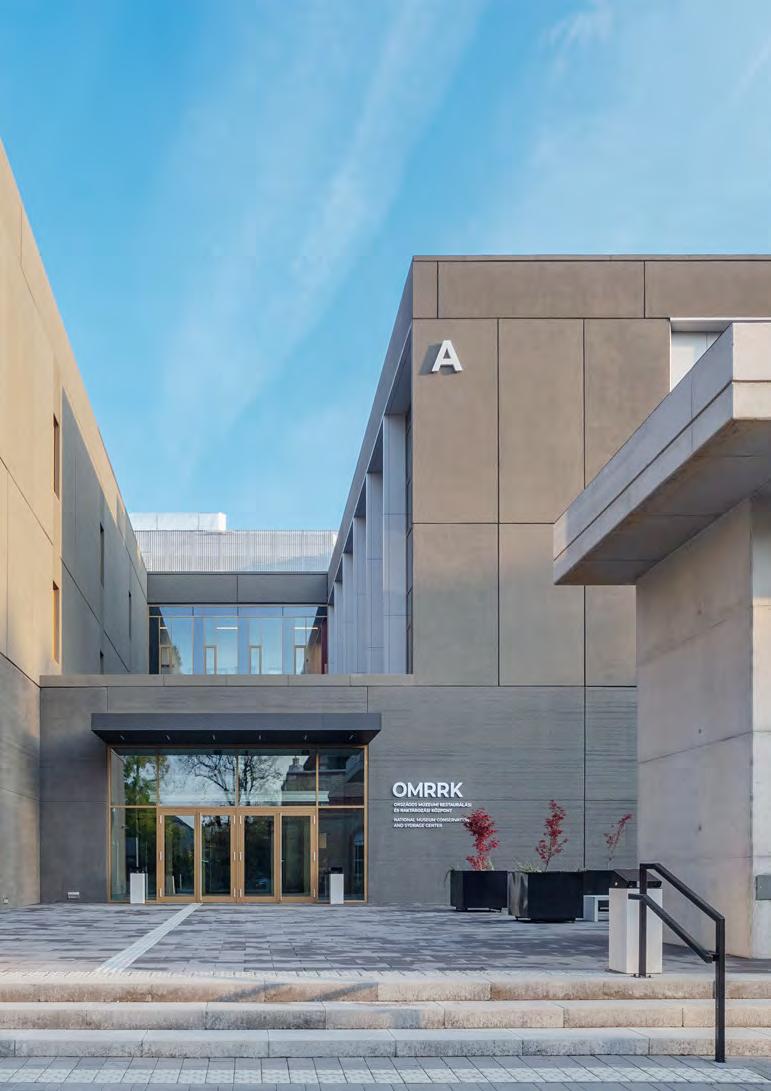
This building housed one of the most prestigious clinics between the two world wars with numerous internationally acclaimed scientists and doctors working here. After World War II, it became a Medical Training Institute and it was later bestowed university status. It was incorporated into the Semmelweis Medical University in 2000 and was eventually closed down in 2007.
A new asset of the project is its central space, created by opening up the former lobby and chapel using the house-within-a-house concept. The contemporary interior architecture of side spaces presents a contrast with the exposed brickwork inside the new space as well as its mysterious arched openings and floating top row of windows. The remains of the building’s original terrazzo floor tiles are built into the landing of the steps leading to the northern entrance. The historicising interior wall and ceiling architecture resulted from the conversion of the building into a chapel, with its only remaining fragment (a medallion) still being visible today. The flat roof terrace is accessible by an exterior staircase.
Bókay Garden, which surrounds the building, is a public park with an area of 13 thousand square metres; it can be visited free of charge during opening hours. Its rental for events requires a permit for private use of a public space. Both entrances of Building ”C” face the park.
The National Museum Conservation and Storage Centre with a floor space of almost 30 thousand square metres provides infrastructure
of outstanding quality for the preservation and scientific research of more than 300 thousand items of the Museum of Ethnography, the Museum of Fine Arts and the Hungarian National Gallery. The large objects of the Museum of Ethnography’s Collection Centre are stored on the ground floor and can be visited by the public based on advance booking and with a guided tour.
After its complex renovation and rehabilitation, Building ”C” of OMRRK was reborn as a facility and event venue conveying historic value to its immediate and broader environment. Its exhibition areas and event spaces with hospitality functions allow a flexible utilisation. An event space with a floor area of 270 square metres is located in the building reconstructed from the chapel (later reception office) of the former Israelite Hospital. During the reconstruction project, which observed the regulations of heritage protection, three venues suitable for hosting events were implemented.
The management of Városliget Zrt. reserves the right to assess the suitability – theme and expected attendees – of the events planned to be held on its premises, and in the event it finds it unsuitable, to not consent to renting it to the party concerned.
Two external spiral staircases lead from the ground floor terrace to the tiled roof terrace with a floor area of 260 square metres, providing the perfect setting for staging drinks parties and lounge events.
Building ”C” of OMRRK has basic-level technical equipment. Those organising and arranging the events can bring their own technical systems.
The event centre’s well-equipped hinterland awaits caterers brought by the event organisers.
People coming by car can use the underground parking of OMRRK (capacity: 64 vehicles). The car park is shared with the employees of institutions on OMRRK’s premises, so it is necessary to check availability in advance, which we can only provide depending on free capacity at the time of your event. The public parking spaces in Vágány Street can be used by those coming by car. The easiest access by public transport is by trolleybuses 75 and 79, as well as buses 30, 30A and 105. The building is only a few minutes’ walk from the Dózsa György Road – Vágány Street stop. It is a bit further (about a 15-minute walk) from the Heroes’ Square stop of the M1 metro line.
The accessible entrance can be found by the terrace.

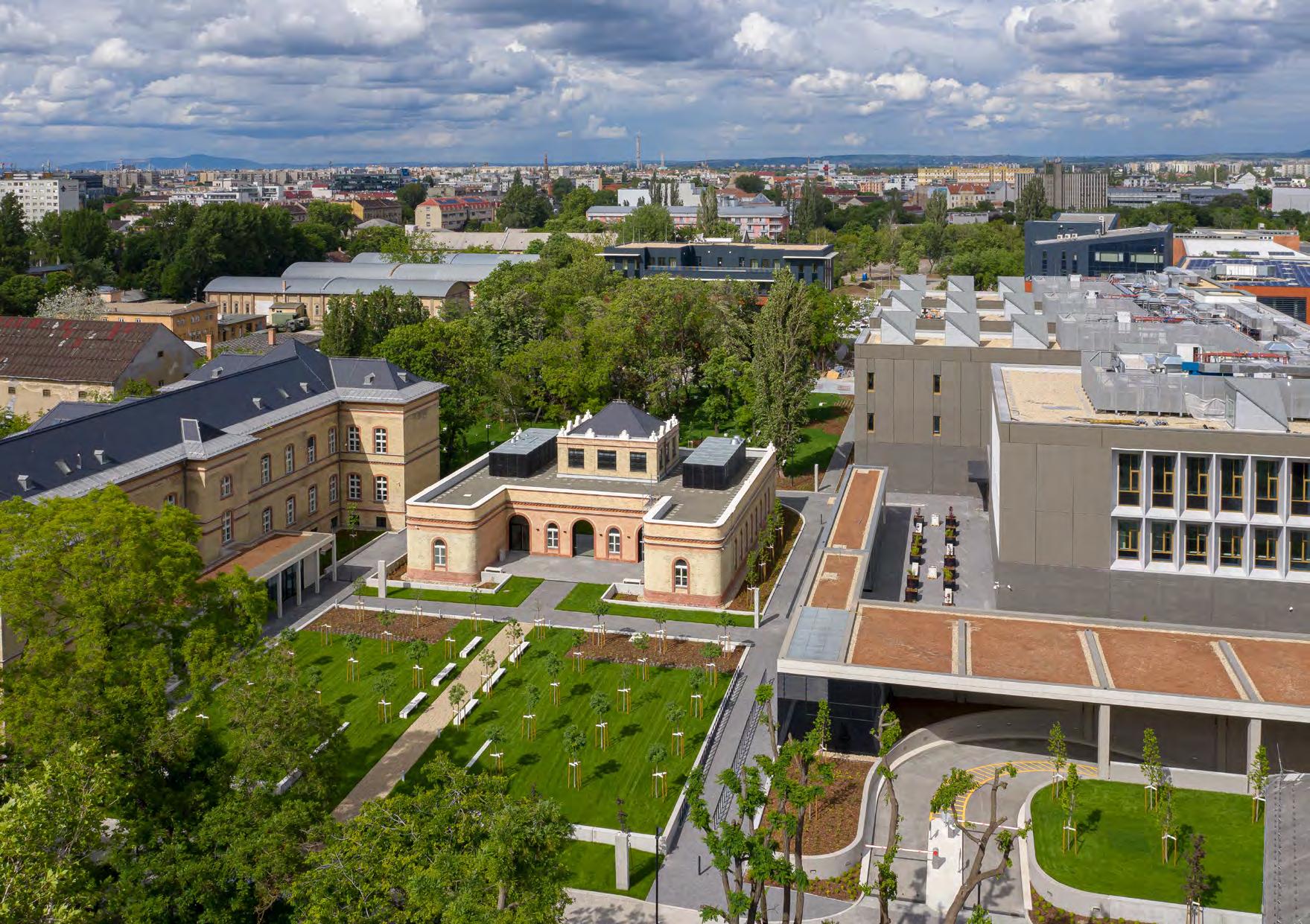
Can the building be accessed directly by car and bus?
Yes, it can be accessed both by car and bus. Public parking spaces in Vágány and Szabolcs Streets can be reached within a few minutes’ walk. OMRRK’s underground parking can be booked based on availability, ideally by providing the license plate number.
Can it be accessed by occasional service vehicles (e.g. for incentive groups)?
The building’s courtyard entrance can be accessed by occasional service vehicles through the gate at No. 2 Vágány Street, next to OMRRK.
Can the building’s immediate environs, which are part of the public park, also be used for events?
Yes, they can but it requires a permit for private use of a public space, which we are happy to help obtain.
How can the Museum of Ethnography’s Collection Centre warehouse for large objects be included in my event?
Groups can visit the large objects warehouse on a guided tour, with advance booking.
Is there a cloakroom and a safety deposit service available?
The building has no cloakroom but a temporary cloakroom can be set up for the duration of your event.
How can brands linked to my event be displayed?
The surfaces of Building “C” of OMRRK can be rented and we can also include the price of displaying company roll-ups inside the building in our price offer. Displaying advertisements in the park entails the use of public space and is liable to a fee.
How can I use cleaning and security services during my event?
Services such as cleaning, security and hostessing during the eventoutside of official opening hours, too - are available for a charge.
can event service staff access the building?
The building’s courtyard entrance can be accessed by suppliers through the gate at No. 2 Vágány Street, next to OMRRK.
Building ”C” of OMRRK can be reached by email at:
rendezveny@ligetbudapest.hu

The Museum of Ethnography, which debuted at the Millennium Exhibition in 1896 in the City Park, moved back to the City Park:
• SPECIAL BUILDING – Selected as the World’s Best Public Service Architecture at the International Property Awards in 2018 and accoladed with the German Design Award in 2023, the museum building presents an exciting sight for those interested in cultural heritage and architecture with its unique indoor and outdoor solutions.
• COMMUNITY SPACE – The arched building design descending to the ground in the axis point of the city defines the Museum of Ethnography as the entrance to the Park. In harmony with this mission, the building will be connected to its environs along its entire longitudinal axis, making it an integral part of the new promenade on the edge of the City Park. The arched main staircase with customer service areas on both ends serves as a passage and provides an enjoyable access to visitors to the heart of the building: to the level of the exhibition spaces. The building operates not only as a museum but also as a community space, since the ground floor spaces and the green roof of the building are open to the public, providing a place for organised groups and groups of family and friends to spend valuable time in.
• UNIQUE COLLECTION - The Museum of Ethnography in Budapest is both a national and universal, historical and contemporary institution preserving Hungarian, European and non-European ethnological material within a unified framework. The museum’s traditional ethnographic material with its national character is outstanding even by international standards: its collections of ceramics, textiles and costumes are the largest collections of their kind on the European continent. For the first time since its foundation, i.e. after more than 150 years, the Museum of
Ethnography houses its special collection in a modern building specifically designed and built for it, worthy of its material.
You can read more about the new building of the Museum of Ethnography here.
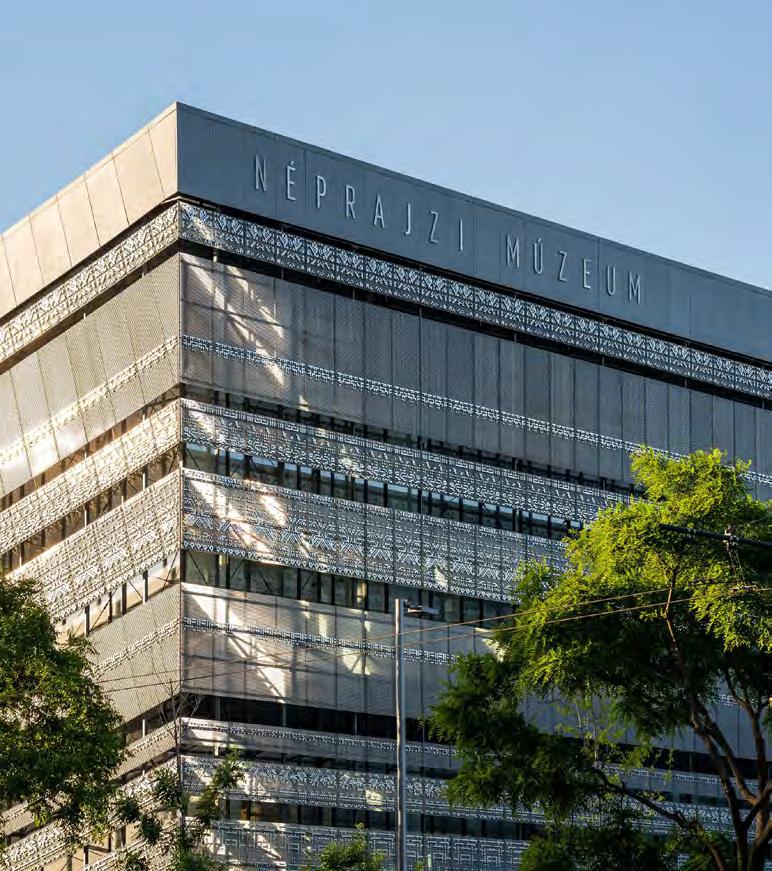
The Museum of Ethnography has been collecting, archiving, protecting and exhibiting cultural relics of Hungarian, European and non-European communities from ancient times to the present in the form of objects, images, manuscripts, film and sound recordings since 1872. The collection, which now has 232 thousand artefacts from both the Carpathian Basin and all over the world, has moved its location many times since its foundation, struggling with a serious lack of space and scant opportunities at its previous location: the building of the former Curia of Hungary on Kossuth Square, which was not suitable for museum purposes.
The institution has now found its final home in a modern, worldclass building of nearly 32 thousand square metres in the City Park, designed to accord with professional standards and to best cater to the needs of its collections and visitors.
The new building, located on Ötvenhatosok Square, was designed by NAPUR Architect. Previously used as a car park, it has a dynamic design with simple contours, allowing it to blend in with the natural features of the park and the surrounding urban fabric, while its arched form lends it the function of a gateway and passage, creating a connecting between the city and the park.
The building houses the Children’s Museum, a library, archive, conference rooms, the Liget Budapest Visitor Centre, catering facilities, as well as 21 thousand square metres of temporary and 4.5 thousand square metres of permanent exhibition space. 60 percent of the building is located below ground level, and the greenery covering the roof serves visitors to the City Park as a community space.
Walking inside the building itself is an experience here thanks to the exciting interior architecture, including the Ceramics Space with thousands of pieces presented in a novel way on one side of the arched staircase, while on its other side it allows visitors to peek into the permanent exhibition space.

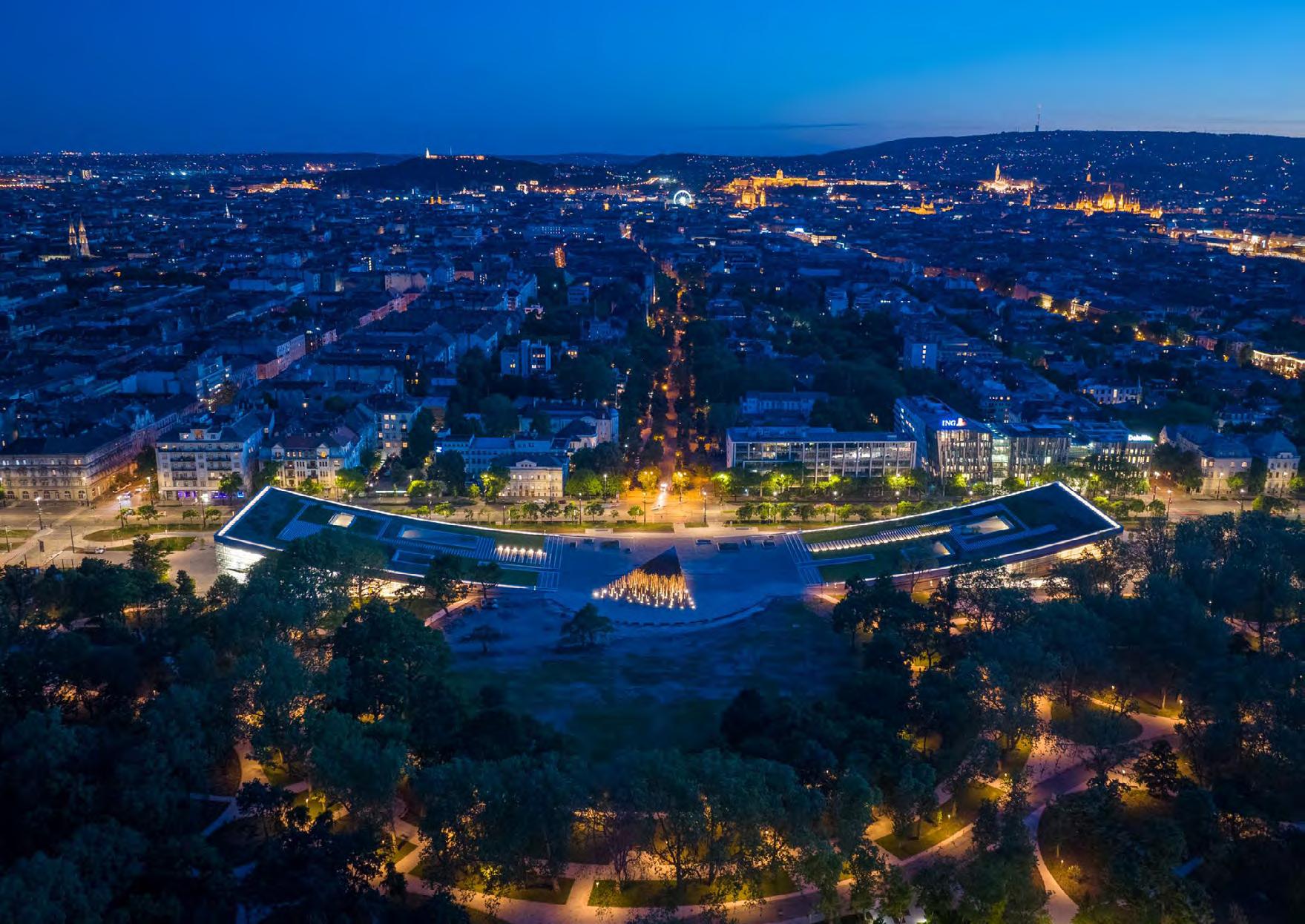
In addition to presenting its unique collection in a thematic arrangement, the Museum of Ethnography, which defines itself as an intercultural institution, uses interactive solutions built on the direct participation of guests, such as single workshops or thematically built up series for children and adults, as well as shows presenting various crafts, a film club, curatorial discussions in the exhibition spaces, 5 O’clock tea, events with music, concerts, and thematic lecture series.
The permanent exhibition on almost 3 thousand square metres, which will open in autumn-winter 2024, and will feature these themes:
• Museum Galaxy
• Age of Exhibitions
• Fieldwork
• The Life of Objects
• Ancient Histories
• Folk Art through the Ages
• Art and Ethnography
• Heritage
CERAMIC SPACE
Connected with the space of the museum’s permanent exhibition is a Ceramic Space. Functional as a kind of ‘visual storage’ this section contains almost 4 thousand ceramics, confirming how even one single type of material can be presented in a wide range of interpretive frameworks, and how it can be linked to cultural areas (lifestyle, use, decoration, style, everyday life and holidays, etc.) that form the foundation of the Museum of Ethnography’s activities.
The Children’s Museum of the Museum of Ethnography, now under construction, presents and explains the mission, exhibitions and events of the institution to children, young people and families in a complex manner, using state-of-the-art museum education solutions.
The sleepover event, the first operating event of the Children’s Museum, entails several hours of inspiring workshop activity and a sleepover among the artefacts. It is quite unusual and different from the everyday, daytime events, and one in which school classes, families, and groups of friends can spend a night in the museum combined and enjoy a thematic workshop.
The main theme of the event is sleep itself. We examine its process and analyse how we adapt to the changing conditions of light and darkness, as well as heat and cold. We examine the various ways in which we get ready for the night, along with the physical and imaginary protection we put in place for ourselves. We reveal what we think about our dreams and try out special beds and sleeping positions using the museum’s extremely rich collection. All this is done within the framework of a game: participants are given the task of completing a half-finished exhibition, becoming ethnographers themselves, searching through the collection warehouse and incorporating their own experiences into a brand new version of the museum’s exhibition, which they themselves created.
MÉTA is the Museum of Ethnography’s unique, public interactive museum education space, a ‘play area’ for families and young people. It is a space for those who want more information, allowing access to publications and the digital holdings of the museum. It also provides an opportunity for schoolchildren/students to work in the museum, for pensioners to take a rest and contemplate what they have seen. It is a space for smaller group events as well as a workshop and demonstration space for schoolchildren doing community service. All of this in one! MÉTA complements the diverse methodological transfer of exhibition knowledge, extends the museum experience with its analog and digital games, with its customisable options for individuals and age groups, and its independent and professionally managed platform. MÉTA is freely available for all. It is a place of retreat, reading, watching films, and private discussions. Here anyone can work, learn, get information, ask questions and search for answers. It is a place where you can play together, try things out, apply your creativity, and choose from lectures, workshops, symposia and other events.

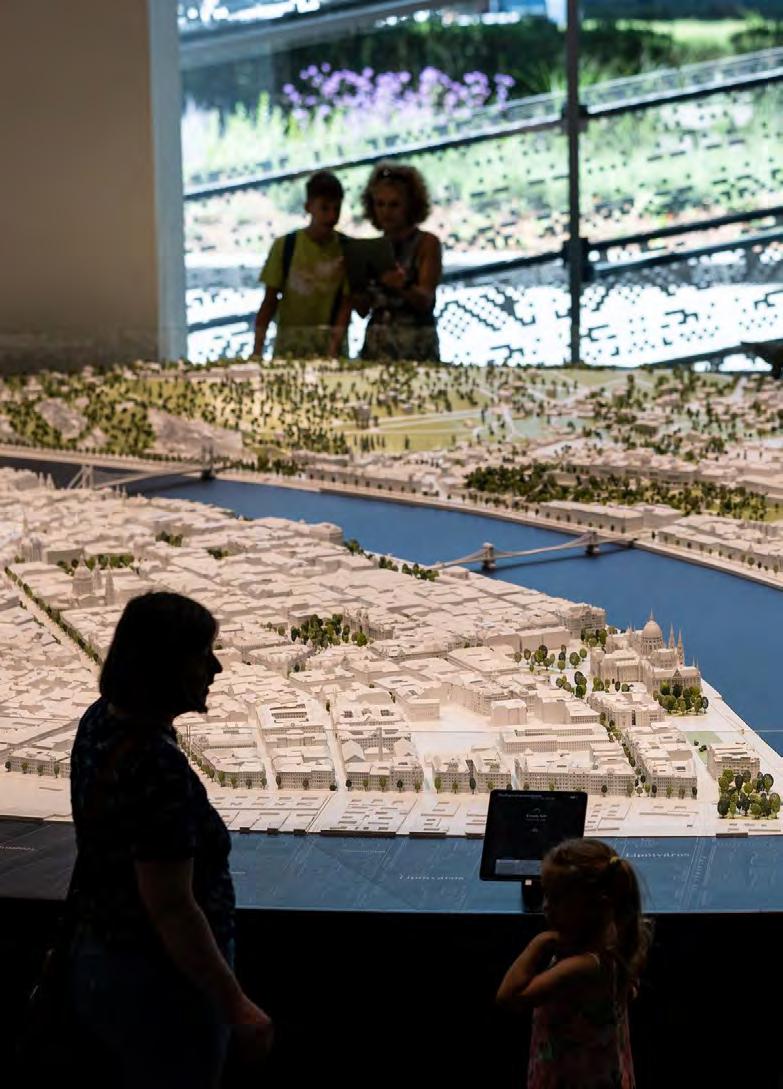
The aim of the Visitor Centre of the Liget Budapest Project is to present the history of the Project, the City Park and its institutions to the public, as well as to knit together the park’s diverse cultural fabric and to provide a wide range of information. The “Golden Age of Budapest” model city, presenting the capital at the turn of the 20th century using ER technology, can be seen at leisure. The main attraction of the Visitor Centre’s exhibition, which can be viewed free of charge, is the 55-square-metre scale model of Budapest with over 6 thousand buildings.
The special roof design of the Museum of Ethnography allows visitors to come to the museum even when they do not want to see a specific exhibition or attend an event organised here. The green roof terrace is an ideal meeting point offering great views of the City Park and the surrounding districts. Visitors can enjoy spectacular sunsets over Budapest from here, too.
A special feature of the roof garden is the walkway, which provides access and entry from street level to the highest point of the building along its perimeter along both sides of the building.
We recommend the organisation of visits to the venues and events in the Museum of Ethnography based on the information below.
The Museum of Ethnography has ten locations with spaces suitable for hosting events.
Q4 2024)


The basic technical equipment and systems (sound system, projection) required for the organisation of events and conferences are available in all the large event spaces of the Museum of Ethnography. Our technical partner will provide the necessary help.
The Museum of Ethnography has two catering units: on the ground floor there is a food court suitable for hosting about 150 people, and there is also a small café. The operator of these units has the exclusive right to provide catering services for the events held in the building and will only waive this right against a fee.
All the communal spaces are made physically accessible.
Access to the Museum of Ethnography is the same as to Heroes’ Square. It can be reached by public transport from the Heroes’ Square (metro line M1, and buses 20/20E, 30). The 56-osok tere stop (trolleybus 74) and the Dvořak Promenade/Damjanich Street stop (trolleybus 70 and buses 20, 30) are only a few minutes away. It can be directly accessed from the Museum Underground Parking facility.

Can the building be accessed by occasional service vehicles (e.g. for incentive groups)?
The building can be reached by buses and other transportation vehicles carrying passengers from Dózsa György Road. Drop-off and pick-up points are available by the side of the Műcsarnok (Kunsthalle). There are 14 bike racks with a capacity for storing 56 bicycles that can be found by the main entrance.
How can the building be accessed by the event organisers using transportation vehicles?
The event organisers and other service providers can access the underground parking space through the goods entrance on the Dvořak Promenade side. Entry is only allowed for vehicles with their licence plates registered in advance and is restricted to the duration of the loading/unloading. Parking is available in the Museum Underground Parking facility.
What power sources and suspension points can be set up in the event spaces?
The interior height of the event halls on the second floor ranges from 4.3 to 7.5 metres. Suspension is possible in the 4x4 grid, of up to 500 kilograms.
What hinterland options are there, including the roof terrace?
The terrace connected to the event spaces can be integrated into your events, although shading is only provided in specific cases and depending on the wind conditions.
Can the immediate environs of the building – including the City Park and the Promenade areas – be used?
Yes, they can but their use requires a permit for the private use of a public space; we are happy to help in obtaining it.
How can I use cleaning and security services during my event?
Cleaning and security services are provided during the entire duration of your event, and can be requested outside of official opening hours for a fee.
Availability of the event spaces of the Museum of Ethnography: rendezveny@neprajz.hu

The House of Music Hungary pays tribute to Hungarian and European musical culture with its award-winning building and solutions unique worldwide:
• UNIQUE BUILDING – Japanese star architect Sou Fujimoto designed a modern and extravagant building by the City Park Lake, with its tripartite structure representing the institution’s triple function: exhibition spaces on the underground level, concert spaces on the ground floor, and music education and multimedia spaces on the mezzanine level. The ethereal and transparent design allows the building to be an organic part of the park. The 99 openings lighting wells of the roof further integrates the building and its environment.
• E XPERIENCING SOUNDS AND MUSIC (Sound Dome) – the cupola space and special technology of the Sound Dome, unique in Europe, make it suitable for reproducing all the segments of the world of sounds: musical, natural, synthetic and concrete sounds, such as noises.
• PERMENENT EXHIBITION OF THE WORLD OF MUSIC AND SOUNDS – presents the history of music from the origins of human sounds to modern trends, with a special focus on Hungarian music and its rich history.
• INCLUSIVE MUSIC SPACE – the basic concept of the events is determined by the meeting of genres, a thematic content and the urge to explore (a kind of educational gesture).
• COMMUNAL MUSIC SPACE – the open-air stage is the venue for musical entertainment, mainly at weekends and especially catering to families and children, while allowing room for young performers.
More information about the new building of the House of Music Hungary can be found here.

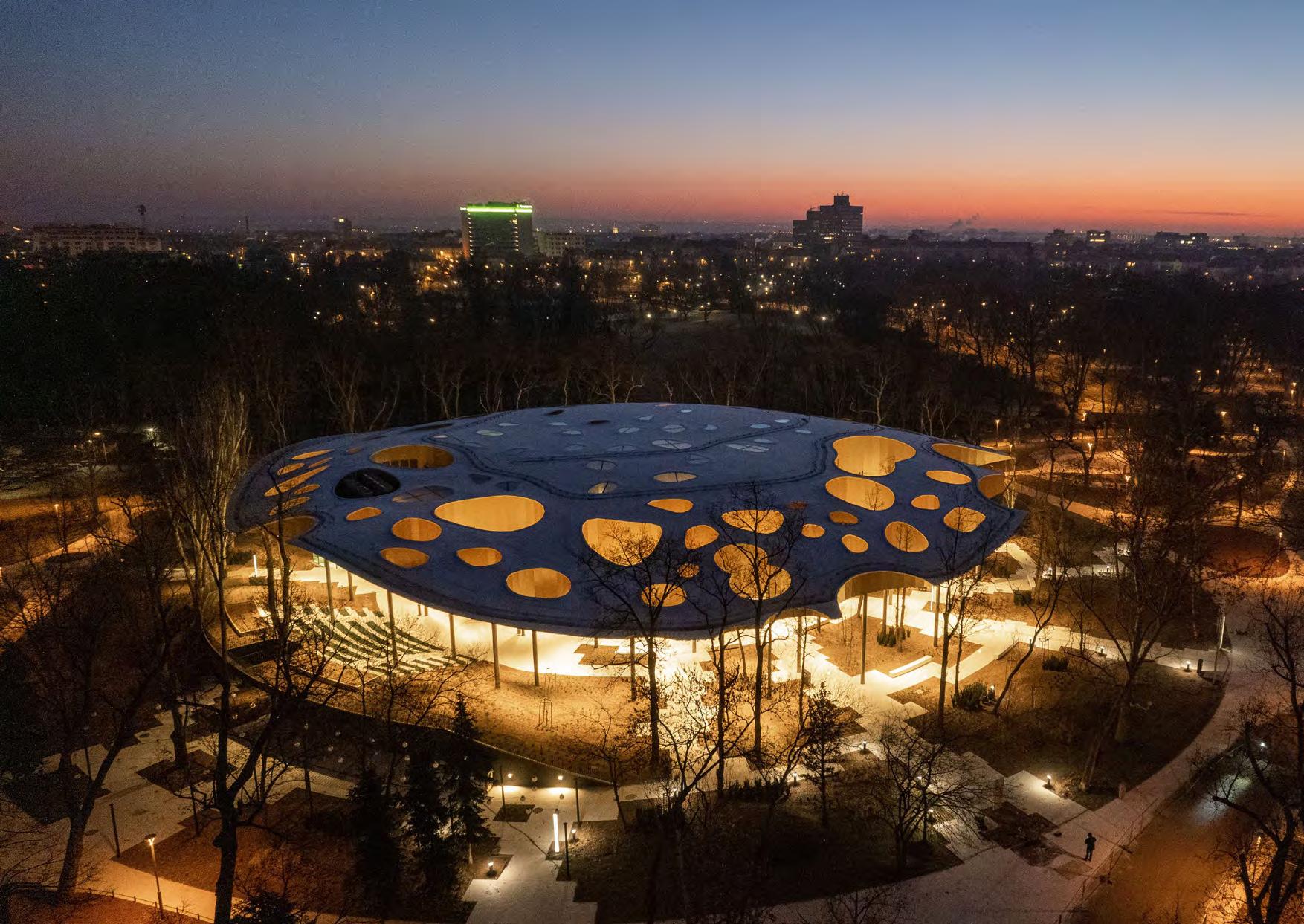
There is barely any cultural field that has given the world more famous Hungarian artists than music. Many Hungarian composers and performers – including Franz Liszt, Béla Bartók, Zoltán Kodály, György Ligeti, Zoltán Kocsis – produced world-class works in the universal language of music, yet there was no educational centre where the treasure of Hungarian music could be explored comprehensively as part of universal music history.
The House of Music Hungary fills this gap, and as a living community space it functions as one of the foremost meeting points of the Hungarian music scene with exhibition, concert and educational halls, an open-air stage, music education workshops, concerts, edutainment opportunities and a unique sound dome. The newly established institution is both a herald and forum for the greatness of music thanks to its diversity of its events, truly worthy of Hungary’s musical past and present and outstanding personalities.

The House tells several ”stories”: a roof, which evokes sound waves, a system of illuminating light wells, a pure palette, play of light, the abstract golden leaves and depictions of birds on the ceiling (inspired by the ceiling of the Great Hall of the Liszt Academy), the staircase supporting itself as a spring structure, and of course, above all, the glass panes.
The House Music Hungary is a worthy candidate for the title of Budapest’s new, iconic building. Drawing on nature and music, star architect Sou Fujimoto dreamed up a modern, extravagant building for music. These two sources of inspiration are clearly discernible in the details too: for example, the building’s signature floating roof was inspired by the visual image of sound waves, but Fujimoto also placed great emphasis on connecting nature and the built environment. The result is a graceful, ethereal, open, transparent, and harmonious building thought through to the finest detail.

The permanent exhibition of the House of Music Hungary presents the history of music from the formation of the human voice to today’s modern trends in a modern museum setting, with special emphasis on Hungarian music and its diverse history. The institution’s main target audience are children, their parents and teachers, as well as young adults, thus many different kinds of people who are not necessarily music professionals and who may not even attend classical music concerts regularly. However, this ’palace of musical wonders’ with special installations and technology allows visitors to personally experience the beginnings of musical harmony and the physiology of the perception of sounds, thus providing a unique experience.
In the exhibition space, located on the underground level, state-ofthe-art technology is used to show that music is actually present and accompanies us at every moment of our lives, from the cradle to the grave. The House of Music is not only for those with a keen ear since it aspires to provide a lasting musical experience for families, groups, individual visitors, music aficionados and everyone interested.
Taking visitors through six main themes, the permanent exhibition highlights the prominent role of Hungarian music as part of the most important periods of the history of European music. Starting from ancient rhythms inspired by the sounds of nature, and the beginnings of sound, it relates the story of Hungarian folk music and its significance through the cycle of life. After that, it presents the most important turning points in musical history, from writing sheet music through the development of polyphony all the way to the 20th century, when technology began to play a decisive role in music. The sounds and styles of different eras can be explored through the work and life of iconic artists. For example, the development of opera as a genre comes alive through Monteverdi’s heartfelt works; we
can pay a visit to Europe’s classical music centres through the music of Mozart, Bach, Beethoven, Erkel and Liszt, and learn about the significance of Bartók and Kodály’s work but also about the role of 20th-century pioneers such as Ligeti and Cage. Our walk-through musical history ends with the main milestones of today’s diverse popular music scene. Interactive solutions encourage both children and adults to create sound and try out various instruments.

The temporary exhibition space provides an opportunity to explore emerging musical topics in depth: it seeks to introduce visitors to an era, genre or emblematic person in depth with two or three shows a year. It also strives to host large-scale international touring exhibitions on music in Hungary. The opening of the House of Music Hungary may well make Budapest one of the most visited cities offering musical curiosities alongside cities such as London, Paris and Vienna.
The first temporary exhibition featured the Hungarian popular music of the last half century, providing an insight into the world of Hungarian pop music in the period between the 1950s and 1990s. From May 2024, the House of Music’s new temporary exhibition, Divas & Icons, will showcase the extraordinary power and creativity of divas, ranging from the greats of opera, silent film stars and screen celebrities to more modern global stars, through the personal stories – as well as original stage attires and costumes – of Rihanna, Björk, Whitney Houston, Janelle Monáe, Tina Turner, Cher, Maria Callas, Edith Piaf, Ingrid Bergman as well as many other defining performers.
The House of Music accommodates a Sound Dome, too. In this special hemispherical space, various sound spaces are created using stateof-the-art visual and sound technology, introducing visitors to the musical and visual world of exciting venues, be it the sounds of nature in the middle of the Amazon rainforest, a dance at a Transylvanian wedding, or the experience of a symphonic concert in Carnegie Hall in New York.
The dome has a 360-degree projection screen and numerous loudspeakers behind it. All visitors need to do is lie down comfortably and enjoy an audio-visual immersion amidst a unique and enchanted ambiance.
The dome space and its technology make it suitable for reproducing all the segments of the world of sounds: musical, natural, synthetic and concrete sounds, such as noises. This unique experience is presented to visitors in the form of 25-minute programmes designed specifically for sound domes.
Resembling a ‘palace of wonders’, this space is located between the permanent and temporary exhibitions. Its mechanical and robot-like structures as well as interactive sound-generating wonders teach visitors about the components of music (sound, timbre, rhythm, melody, harmony). An interesting feature is an organ reimagining one of György Ligeti’s unrealised visionary designs.
At the musical playground children can enjoy stepping and climbing games and outdoor musical instruments composing melodies at a touch.

We recommend the organisation of visits to the venues and events in the House of Music Hungary based on the information below. The permanent and temporary exhibitions can be visited in time slots, so it is advisable to make arrangements in advance.
On weekdays from 10 am to 3 pm, school groups take part in workshops based on a special music educational concept. From Friday afternoon, the weekend events are mainly events of entertainment and popular science based on these subjects:
• Authentic music: original and dance-house folk, folk-related world music, traditional music (Hungarian and international);
• Classical music with a new slant (moderated event, with inspiring discussions, with a programme open to other genres and styles);
• Jazz (not so conventional, more catering to world music, and free jazz productions);
• Pop (primarily unplugged, with the genre of song in focus);
• Electro-acoustic and electronic music (using the technical equipment of the House);
The basic concept of the events is underpinned by the meeting of genres, athematic approach and a thirst for knowledge (a kind of pedagogical gesture); in every genre there is a children’s event in the house of Music Hungary.
On the ground floor of the House of Music Hungary, there are two almost completely transparent halls, where during a concert, dance show or workshop visitors and participants can feel as if they are sitting in the open air, under the foliage of the trees. The concert hall can seat 340 people but, thanks to its adjustable stage technology, it can also be used for seated or standing concerts and other performances. The second hall is primarily an auditorium for lectures, workshops, smaller productions, and conferences. In the garden area of the City Park Lake, there is also an open-air stage for daytime and evening concerts and small-scale music events. Visitors to the House of Music Hungary can listen to performances while sitting on the grass on the hillside or in the garden bistro next to the open-air stage.
The institution lends an important role to popular science, education and talent scouting. Music workshops, dance-house events and museum education workshops are available for both adult and children’s groups interested in music. Thematic series are also organised linked to the exhibition, where visitors can familiarise themselves with the diverse musical culture of the world. The House of Music Hungary supports and welcomes amateur and novice musicians as well as musical trends and is happy to provide them with the opportunity to appear on stage.
There are seven spaces in the building of the House of Music Hungary for entertainment and events.
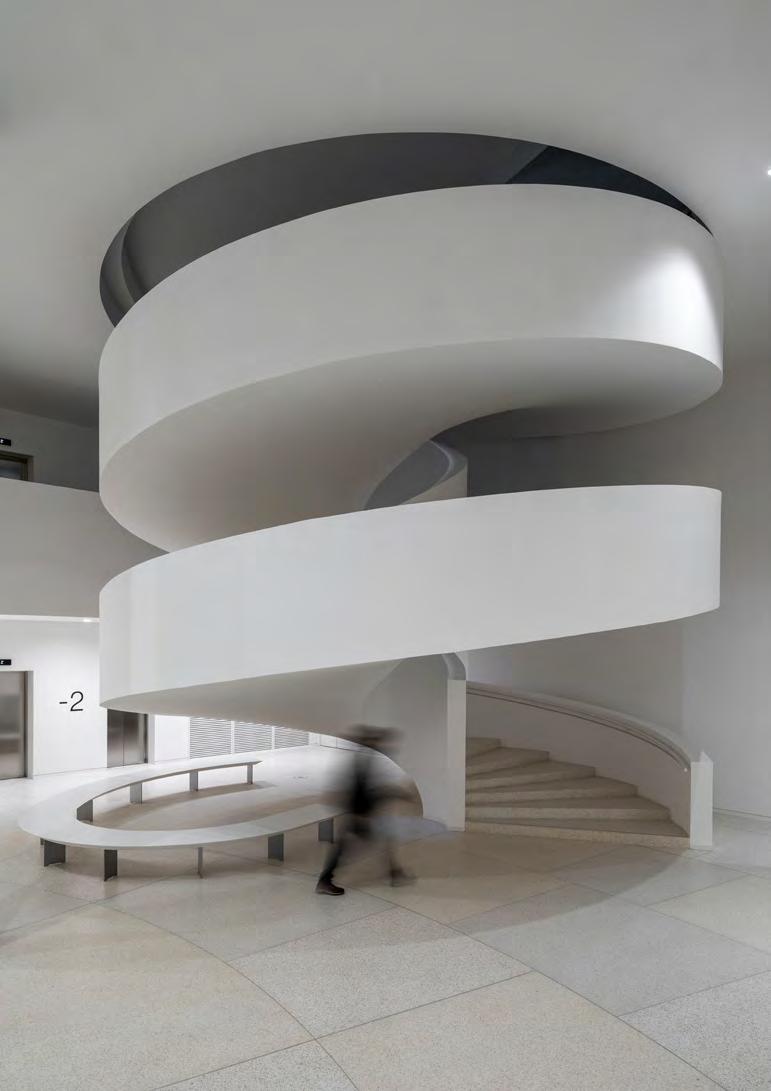
The basic technical equipment and systems (sound system, projection) required for the organisation of events and conferences are available in all the event spaces of the House of Music Hungary.
The House of Music Hungary has three catering units: visitors can use the bistro with a capacity for about 60 people on the ground floor, a smallish café on the first floor, and a garden bistro overlooking the City Park Lake where there is a food court suitable for hosting about 150 people, and there is also a smallish café. The operator of these units has the exclusive right to provide catering services for the events held in the building, and will only waive this right against a pre-negotiated fee.
The shortest route to reach the House of Music Hungary is from the direction of Heroes’ Square and Dózsa György Road. By public transport it is only a few minutes away from the Heroes’ Square stop (metro line M1, and buses 20/20E, 30), the 56-osok Square stop (trolleybus 74) and the Dvořak Promenade/Damjanich Street (trolleybus 70 and buses 20, 30) stop. The building is a five-minute walk from the Museum Underground Parking facility.
The communal spaces of the building comply with the regulations pertaining to physical accessibility.
Can the building be accessed by occasional service vehicles?
A permit from Budapest Közút Plc is required for entry but parking is generally not allowed near the House, only in the nearby streets and in the Museum Underground Parking facility (with the exception of performers and suppliers for the duration of loading/unloading).
Both concert halls have a good piano: the larger hall has a Yamaha CFX grand piano, and the smaller one has a Yamaha SX3 available for performers. There is also podium and a conductor’s podium and stand.
What is the capacity of the dressing room available for the performers?
The building has two dressing rooms, each with a capacity for 20 persons, as well as four additional private dressing rooms suitable for 1-4 persons.
Is there a hinterland option in the surrounding area of the City Park?
It is possible but subject to a permit for private use of a public space, and a fee.
Contact for the House of Music Hungary:
rendezveny@zenehaza.hu
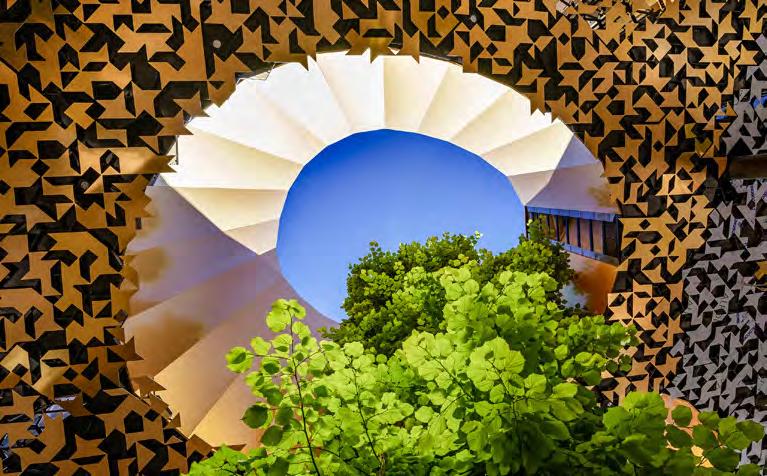
Városliget Zrt.’s asset management extends to the area delineated by Állatkerti Boulevard, Dózsa György Road, Ajtósi Dürer Road and Hermina Road in District XIV in Budapest. Events organised within this area are permitted but require a permit for use of public areas applicable to the given area.
Városliget Zrt., as the asset manager of this public area decides on its approval of usage of the given public space based on individual assessment in accordance with the relevant legal regulations. Since the decision making process does not fall under the legal category of proceedings instituted by a public authority, Városliget Zrt.’s does not accept any appeal or legal redress that would pertain to such proceedings. During the assessment of requests for use the public space, priority is granted to activities linked to the implementation of the new national public collection and the Liget Budapest Project as well as to activities connected to the construction, repair and maintenance of the buildings.

As a key element in the renewal of the City Park’s green areas, several important and popular spaces and areas have been revamped besides the large, extensive green areas (Napozórét and Mimosa Hill):
• King’s Hill – formerly called Sledging Hill, this area served as the venue for the premiere of the rock opera Stephen the King, presented here on 18 August 1983. As a tribute to this, it was renamed King’s Hill.
• Big Field – the largest clearing of the City Park, this area is in the direct proximity of the House of the Hungarian Millennium and the House of Music Hungary. The Nagyrét, which is now a popular area for families and dog owners, had previously been occupied by the Industrial Hall, built for the Millennium Exhibition and by the iconic, monumental illuminated fountain representing the legend of the fairy called Sió.
• Picnic Garden – suitable for open-door recreation and picnics next to the Mihály Mőcsényi Botanical Garden and the House of the Hungarian Millennium.
• Promenade – running parallel with Dózsa György Road, the Promenade was built on the site of a former car park between Ajtósi Dürer Road and Heroes’ Square. The roof gardens of the Museum of Ethnography provide a unique space and experience on the Promenade, which is also home to the 1956 Monument.
• Heroes’ Square – together with Andrássy Road, Heroes’ Square is a UNESCO World Heritage site. The imposing square, rich in symbols, connects Andrássy Road with the City Park. The sculptures in the niches of its arcaded monument feature the most important rulers in Hungary’s history, supplemented by a sculptural ensemble of the Seven Chieftains. The 36-metre high column on the square is surmounted by Archangel Gabriel, and placed before it is the symbolic tomb of Hungarians who died a heroic death.
• Mimosa Hill – This part was intended to be a viewing point already in the original designs made for the City Park by Christian Heinrich Nebbien. Now it is the venue for a gas balloon, inspired by Pál Szinyei Merse’s painting The Balloon, offering breath taking views from a height of 150 metres.
• Sunbathing Field – located behind Vajdahunyad Castle and adjacent to the Big Field, this peaceful clearing, away from the noise of the city, will be revamped in the next development stage of the Liget Project.
*The usage of an area that requires the closure of the Károly Kós Promenade requires the necessary permit for use of public spaces as well as a permit obtained from Budapest Közút Plc. Areas in the City Park that cannot be used for events are the Sensory Garden and the Main Playground.
More about the renewed green areas and their functions here.
MIMÓZA DOMB MIMOSA HILL
Napozórét Sunbathing Lawn
Hermina út
KRESZ Park Children’s Tra c Park
Vakok Kertje Sensory Garden
HŐSÖK TERE HEROES’ SQUARE
Vajdahunyad Vára – belső udvar Vajdahunyad Castle – garden
VÁROSLIGETI-TÓ VÁROSLIGET LAKE
Dózsa György út
Múzeum Mélygarázs Museum Undergound Parking
Mőcsényi Mihály Botanikus kert Mihály Mőcsényi Botanical Garden
After completing the application form available on the website here and obtaining the documents specified in the list of documents to be attached, the Applicant can also submit a request for a permit for private use of a public space on paper. In this case, the application and the documents to be attached (Appendix No. 1) must be signed and sent in original copies by post to the address of Városliget Zrt.: 1386 Budapest, Pf.: 910. Sending the necessary documents by e-mail does not replace the Applicant’s obligation to submit the original copies by post. The request for a permit for private use of a public space must be submitted at least 30 days prior to the starting date of the use of the public space indicated. The consent to use the public space does not replace any other (e.g. construction, health, aviation, law enforcement, etc.) official permits, contributions, opinions, and declarations by authorities whose issuance is required by law.
• Detailed information about the use of public spaces can be found here.
• The detailed list of activities and services requiring a permit for private use of a public space can be found here.
• No permit for private use of a public space is required for activities listed here.
• No permit for private use of a public space can be granted for activities listed here.
Public spaces can only be used by the holders of the consent to the private use of a public space and by contributors to the event. The consent for the use of the public space cannot be transferred to a third party, as it is intended exclusively for the holder; however, this does not limit the right of the holder to employ contributors for the use of the public space.
For the use of public spaces, a public space usage fee of the amount specified in Appendix No. 2 of the relevant Regulations must be paid, or other compensation specified in the contract must be provided.
Further information and details: terulethasznalat@ligetbudapest.hu
A permit is required to drive into the City Park. Permits are issued by Budapest Közút Plc.

The gastronomic offer of the City Park ranges from pop-up units and street-food through cafés and traditional kiosks all the way to high quality fine-dining restaurants.
• MILLENNIUM CAFÉ – The 130-year-old House of the Hungarian Millennium has a unique café and restaurant, providing a unique venue for traditional events, pleasant dining, business lunches and coffee with friends in a historic environment. Surrounded by Zsolnay ceramics in a milieu evoking the golden age of Budapest, visitors can embark on a journey through scents and flavours, back into the past. The terrace of the restaurant under the trees of the City Park is an island of tranquillity. The comfortable seats, tasteful furnishings and shades will make breakfast and snacks here not only comfortable but also memorable. | millenniumkavehaz.hu
• B alloonFly Garden – gastro corner between the City Centre’s new sports complex and playground, where you can take a break and have a coffee, smoothie or a snack. The kitchen is excellent, with lunch menus available every weekday. facebook.com/leghajokert
• Pavilion Garden – the three new pavilions were reconstructed based on the orientalist designs made in 1860 by Frigyes Feszl (the architect of the Vigadó in Pest), evoking the atmosphere of the time with their interiors too. They are real cultural communal spaces providing a permanent venue for music and other cultural events. Their gastronomic offer includes the city Park’s much-loved ‘lángos’ and pizza, crépes and chimney cakes and other delicacies. The bar’s drink list is also extremely varied. facebook.com/pavilon.budapest/

• Picnic Garden – besides the unique flavours, the Picnic Garden is a relaxed and informal place providing some carefree leisure in a natural environment and interesting events in one of the most scenic locations of the city Park: the Mihály Mőcsényi Botanical Garden. Grilled food, street food, cold and hot drinks perfect for any occasion, as well as picnic baskets of your choice are combined to create a unique experience. facebook.com/Piknik-Kert-102804005211882
• BRGR Burger – drawing on the expertise of the Robinson Restaurant, the BRGR Burger seeks to give new meaning to street food and create one of Budapest’s most scrumptious burgers. When it comes to burgers, not many can say no, regardless of the time of day, it proves to be the right choice in the afternoon and in the evening too. facebook.com/brgrbudapest
• The Saddle – Drinkery – the building of this bistro was once an auxiliary block of the Artesian bath, and then, as the capital’s first hotel, it provided a place of rest for travellers, and later one of the equestrian troops of the gendarmerie was stationed here. This is evoked by the name of today’s drinkery: The Saddle. The culture bistro located between the oaks and willows of the City Park provides an atmospheric place for outdoor leisure on more than 800 square metres from early spring to late autumn, wand in colder months visitors can enjoy The Saddle’s hospitality indoors, while experiencing the quiet of the park. In the evenings the place caters to young people, and in the daytime they focus more on families. In 2015 The Saddle won the special award of the dog-friendly Place of the Year competition. | nyeregitato.hu
• Pántlika Bistro – this venue under its cultic roof in the shape of a sinus curve has been operating in the City Park as a bistro since 1963. Pántlika will bring back the nostalgia of the old days, enhanced by its numerous retro objects. Pántlika was one of the first in Hungary to serve hamburgers, regarded as a quality culinary experience. In 2013 its San Pedro burger won the title
of best hamburger of the year. Those with a more traditional palate will love the bean soup from Transylvania, based on Aunt Jolán’s 25-year-old recipe, and her cottage cheese dumpling too. As a responsible gastro point, Pántlika welcomes everything that is green. They are passionate supporters of live music: guests can listen a wide range of live music (including classical live Roma music), DJs, organic live sets and rising young bands. pantlika.hu
• ROBINSON RESTAURANT – the restaurant, situated on the island on City Park Lake, opened in summer 1989. Thanks to its splendid location, it soon earned itself a name with the local inhabitants and foreigners alike. Its high quality combined with professionalism result in an exciting world of flavours. The upstairs section is a steak house, awaiting those who are passionate about scrumptious steaks made with outstanding technology. | robinsonrestaurant.hu
• Városliget Café & Restaurant: the restaurant on Olof Palme Promenade is an excellent choice for romantic couples, families, dog-owners and even tourist groups. In the summer, guests can enjoy the marvellous panorama of the City Park Lake from the terrace and a view of Vajdahunyad Castle. In winter, those coming from the ice rink are welcome to try the wide selection of food and drinks. One of the specialties here is the coffee, made with locally ground coffee beans. | varosligetcafe.hu
Hungária körút
HŐSÖK TERE
MIMÓZA DOMB MIMOSA HILL
út
Hermina út
Since its conception, the city Park has inspired and welcomed lovers of sport and has played a truly important recreational role in the lives of those living in the nearby districts. This is why the Liget Budapest Project paid special attention to strengthening and expanding sports and outdoor game functions promoting a healthy lifestyle.
One of the most important steps in the process was the opening of the new Városliget Sports Centre, which is one of the most versatile sports complexes in Budapest. Situated on the southeastern part of the City Park, at the junction of Ajtósi Dürer Road and Dózsa György Road, it is easily accessible, and almost a dozen different sports can be tried here by those in favour of active leisure, from young to old, and from amateurs to professionals. It provides a modern and safe environment for sports enthusiasts with men’s, women’s and accessible changing rooms as well as drinking fountains and bike racks serving their comfort.
• 5 multifunctional sports tracks
• a 2-km and a 200-m running circle
• 2 outdoor fitness areas
• 2 teqball areas
• 17 chess tables
• 4 table tennis tables
• 1 climbing wall
• 1 minipool course (skateboard)
• 1 pumptrack course (bike, BMX)
• 1 petanque course

The Városliget Mini Arena is Budapest’s new and most modern artificial turf football pitch. A unique feature of the 43x23-metre pitch is its modern lighting system, which allows exciting matches to continue even after dark. It is surrounded by a comfortable stand, from where family members and fans can watch the friendly matches. Two covered substitute benches are installed by the touchlines, while the scores can be followed by the players and the supporters on a digital scoreboard. Comfort for the football players is provided by modern changing rooms, bike storage and drinking fountains by the pitch.
Városliget Mini Arena:
• lighting system
• digital scoreboard
• covered substitute benches and stand
• protective net
The Basketball Mini Arena is one of the favourite places of amateur and professional basketball players. The standard-size court is rubber-surfaced and protected by a 4.2-metre netting. It can be rented at favourable rates on the Liget Budapest Project homepage. Comfort for the players is provided by modern changing rooms, bike storage and drinking fountains by the court.
Basketball Mini Arena:
• rubber-surfaced basketball court
• 32 x 19 m
• s tandard court markings
• lighting system


This part of the park with an area of more than 13 thousand square metres has some fifty special playground features. The central element of the Main Playground is a three-level climbing frame, inspired by Pál Szinyei-Merse’s painting titled Balloon. This children’s wonderland is fitted with slide systems, nest swings, roundabouts, seesaws and traditional swings, rope courses, spinning toys, solo and duo spring toys, trampolines as well as various sandpits and water toys for all age groups. The opening of the Main Playground was the first milestone on the road to creating a family- and children-friendly City Park. Thanks to the Liget Budapest Project, seven new playgrounds (e.g. Lakeside Playground, Small Playground) will be built in the revamped park.
Since we think it important that the renewed park should be freely enjoyed by everyone, dogs are permitted in the whole City Park, except the playgrounds and the construction sites. Moreover, two dog adventure parks with play features, agility courses, ballparks and dog runs await the four-legged friends on Hermina Road and Ajtósi Dürer Road.

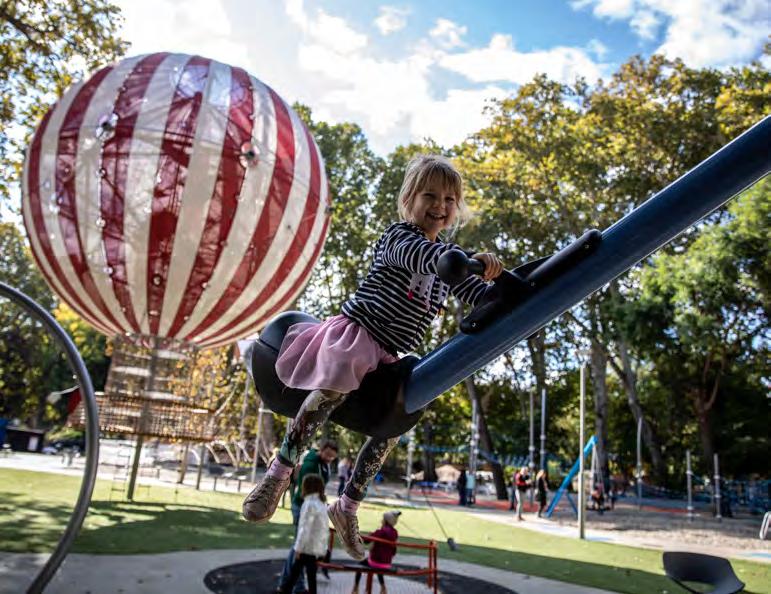

The predecessor of the Mihály Mőcsényi Botanical Garden was established in 1967 by the Metropolitan Gardening Company (Főkert) on its centenary to exhibit well-known and less well-known plant species, herbs, economic plants and vegetable garden plants, spices, annual flowers as well as the most popular aquatic, swamp and rock garden plant series. Currently the botanical garden displays the most valuable species of the City Park’s flora, such as the Lebanon cedar, tulip tree, magnolia and paper mulberry. A gurgling stream, an ornamental pool, a hut with a roof, benches, walks and arbours cater to recreation for visitors, and a statue of Mihály Tompa can also be seen here.
Thanks to the renewal of the City Park, the Mihály Mőcsényi Botanical Garden has become a colourful and pleasant communal space as well as a knowledge centre of natural science, providing a venue for openair biology and natural science lessons for the neighbouring schools.
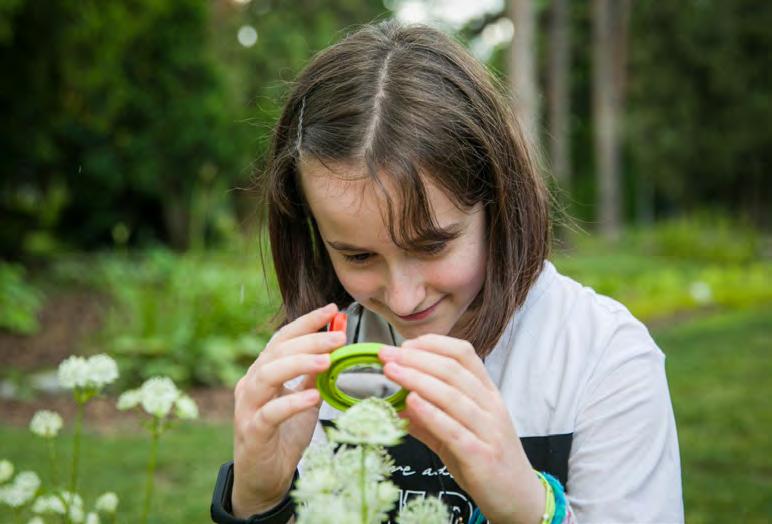

The sports facilities fundamentally cater to mass sports, so they cannot be used for individual events.
The use of public and green areas near the sports facilities by groups requires a permit for the private use of a public space from Városliget Zrt. (relevant information here). Informal events for friends and families can be organised without a permit for private use of a public space.

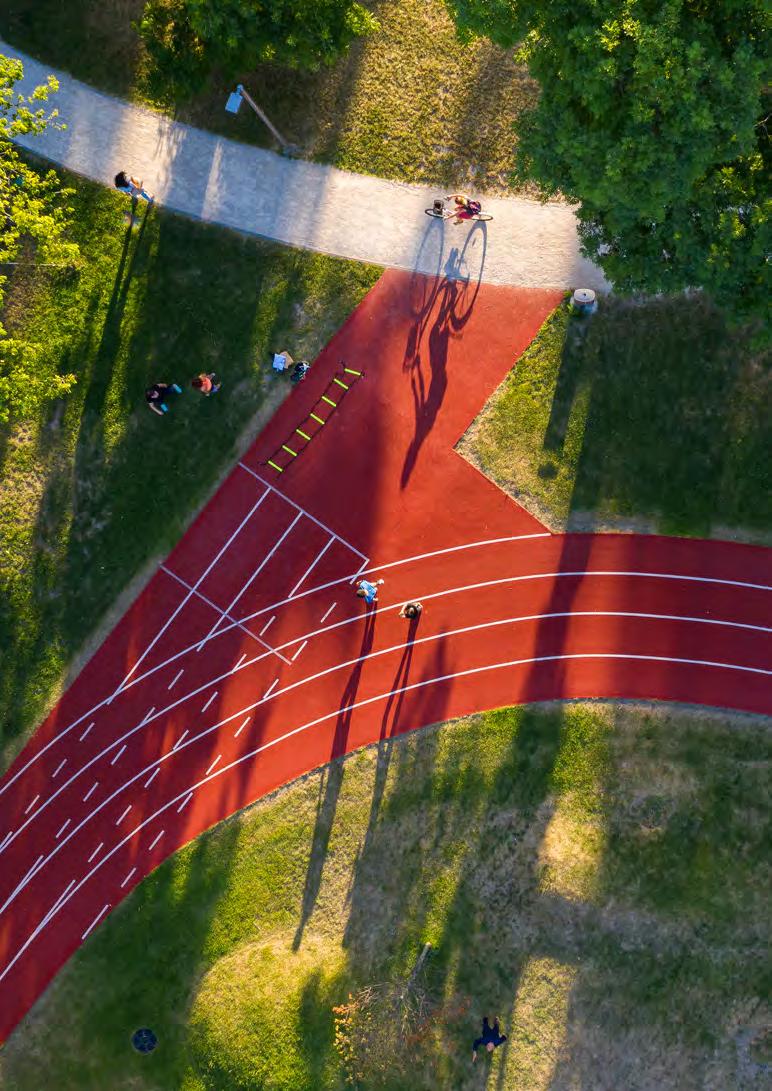
Besides the renewal and expansion of the green areas of the City Park, the main objectives of the Liget Budapest Project include the reduction of vehicle traffic going through the park due to the huge environmental pollution imposed on the flora and fauna here to this day. As a first step, we demolished the aboveground car park on 56-osok Square. Since December 2020, visitors can use the Museum Underground Parking facility, with a capacity for 800 cars on three levels:
• 751 general parking spaces
• 17 disabled parking spaces
• 24 spaces with EV chargers
• 71 spaces for motorbikes
Uniquely in Europe, the interiors of the Museum Underground Parking are decorated by reproductions of twelve masterpieces by renowned Hungarian artists from the collection of the National Gallery, reflecting the close connection between the City Park and the arts, looking back on a century-old history.
The underground car park is open non-stop, and is operated by Városliget Zrt. Its two operational periods are:
• Daytime (6 a.m.–10 p.m.): operation with on-site staff
• Night time (10 p.m.–6 a.m.): entrances and exits are closed by grates; no on-site staff; 0-24 technical dispatcher and security service for the basic operation and supervision of the facility
Visitors attending the various events organised in the City Park can park in the facility at a reduced parking fee. For more information, please contact partner@ligetbudapest.hu.

Városliget Zrt. regards it a key strategic objective to provide not only a green environment for visitors to the renewed City Park but also to make high quality services available, while aiming to integrate other world-class services available in the City Park into its visitor concept and service platform to harmonise it with the City Park service concept.
Liget Budapest offers the following solution for its business partners:
• One-stop-shop system for services provided to all Liget Budapest business partners
• Cultural, sport and leisure or children’s activities to supplement events and professional programmes
• Parking catering to large capacity, individual needs, and offering reduced rates for events
One of the smart solutions is Customer Experience Management (CEM), with its elements (building a visitor database, online sales, online communication, reduced fee management) allowing the active users of the City Park to enjoy communal experiences and functions.
We built the Liget+ community to provide the highest possible level of services to visitors coming to the renewed City Park as well as a continually expanding range of reductions in the institutions and service points on its area.
Liget+ can be reached on the Liget services homepage. A name and email address is all that is needed to join the community.
We regard building the Liget+ visitor community as important because:
• it allows us to provide higher quality visitor experiences to the Liget+ community members by making services more convenient and making additional online services available;
• it allows us to encourage visitors to return to the City Park more often; and
• it allows us – especially in the foreign tourist segment – to help Liget+ members to have access to as wide a spectrum of services as possible during just one visit.
The Liget+ community was launched in September 2020 with the following services:
• unlimited Wi-Fi access on the renewed parts of the City Park
• Unique QR codes generated for members allowing them to use all the outdoor toilets free of charge
• 10% reduction of prices in the Liget Budapest gastronomic facilities
• 10% reduction of prices for online services services (buying tickets, e.g. to the House of the Hungarian Millennium, booking and using sports facilities)
Premium memberships offering special services optimised for groups of visitors are available for Liget+ members.
In 2024 we introduced the Liget Budapest Gift Voucher with a value from HUF 5,000-150,000. It can be used at 13 venues within one year of purchase, allowing holders a free choice in selecting and combining the kind of facilities they wish to use.
The Liget+Sport membership, valid for an unlimited period of time, allows holders to use the changing rooms of the Városliget Sports 24/7, and book the sports facilities at significantly reduced rates. We recommend this membership for those visitors to the City Park who regularly use the bookable facilities of the Sports Centre and often come to the City Park for active recreation, so they want to have a shower and get changed comfortably in a pleasant environment.
The Liget+Mobility membership, also valid for an unlimited period of time, entitles holders who come to the City Park – to visit the exhibitions of the House of the Hungarian Millennium, to the Városliget Sports Centre, to use the running circle or come to the Main Playground with their families – to park in the Museum Underground Parking facility more simply and at reduced rates.
Members can use contactless parking, the gate opens automatically without a printed ticket; parking is free for the first 30 minutes; after the first 30 minutes users are charged based on a 15-minute rate; electronic receipts are issued automatically after the parking time is over and sent to the users by email.
rendezveny@ligetbudapest.hu
